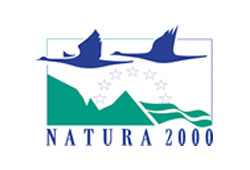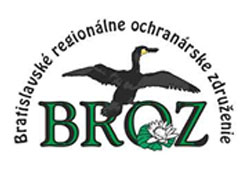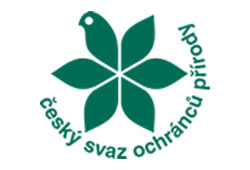Targeted species
Gentianella praecox subsp. bohemica
Gentianella praecox subsp. bohemica is an endemic species of the Czech Massif and a sub-endemic species of the Czech Republic (CZ). Its historical distribution range includes CZ, northern Austria, Bavaria and the south of Poland. It is credibly documented in more than 650 sites in the CZ and a few dozens of historical sites in Austria, Poland and Bavaria. Since 2000, it has been, despite intensive searching, observed only in 111 sites in its distribution range: The Czech Republic – 69, Austria – 30, Germany – 8, Poland – 4. In 2014, 73 recent sites (i.e. after 2000) were known in the CZ, but the flowering plants were observed in 38 sites only. Of this, the 11 SCIs involved in the project, cover 20 of the monitored sites. In the average number of flowering specimens, it is 59 % of the species population in CZ. Total number of flowering plants 574 - 8 685 in project SCIs in the Czech republic vary between particular years.
The decline of the population started approximately in 50´s and was a result of changes in the landscape cultivation. The pastures and allotments extensively grazed by especially the goats and the sheep disappeared relatively fast. After grazing stopped, the stands became denser and the sites overgrew with tree species. Some sites were afforested. The most important part of the life cycle is sprouting of seeds and the seed bank survival. For sprouting of seeds from the seed bank, the limiting factor is thickening of sods and occurrence of mosses. In cultivating the Gentianella meadows, proper timing of mowing is necessary, as during common mowing in the August/September period, there is a risk of deterioration of the plants which start to bloom, are in bloom or ripen. The special management which reflects above negative aspects needs to be applied on the sites with Gentianella.
Osmoderma eremita
The beetles prefer the habitats exposed to sunshine, particularly old trees with cavities, where the beetles mate. Presently, the species occurs locally in the Czech Republic. The highest number of sites and findings is in southern Moravia and southern Bohemia. The species is threatened by removal of old trees (e.g. in parks and forests of its occurrence), disposal of alleys and burning out of tree cavities. In southern the Slovak republic, the core of the populations are found in pollarded willows. Due to abandonment from traditional management (regular pollarding), the willows are gradually dying out and the habitat is getting lost.
Carabus menetriesi pacholei
A relic species living exclusively in original peatbogs and valley and mountain meadows. In the Czech Republic territory it occurs in 3 isolated populations – in mountains Krušné hory (Ore Mountains) , Šumava (Bohemian Forest) and Upper Austria. It is endangered by destruction of peatbogs, mainly due to their draining and intensive extraction of peat deposits. Other reasons include degradation of peatbogs due to inappropriate water regime or overgrowing with the pioneer tree species.
Targeted habitats
6110 - Rupicolous calcareous or basophilic grasslands (Alysso-Sedion albi)
These are predominantly rocky plateaus and open patches or disturbed areas in dry grasslands, mostly on limestone, less frequently on diabase, spilite, basalt, and calcareous conglomerates. The main threat to these habitats is human activity, which leads to changes in the original species composition in favor of non-native species. Another significant threat is the absence of traditional land management—especially mowing and grazing—which results in the overgrowth of the habitat with dominant grass species, self-seeding trees, and invasive plants.
As part of the CZ-SK SOUTH LIFE project, we carried out the restoration of habitat 6110 at the sites of SCI Nerstský lom, Pastvina u Přešťovic, and Opolenec. The restoration was carried out by removing self-seeding trees and invasive plants, reintroducing mowing, and implementing extensive grazing with sheep and goats.

Habitat 6110 – SCI Nerestský lom
6210 - Semi-natural dry grasslands and scrubland facies on calcareous substrates (Festuco-Brometalia)
The habitat is significant due to the frequent presence of orchid species. It primarily occurs on sunny slopes, usually on moderately deep to deep soils. This habitat is also threatened by the spread of undesirable species and changes in land management, particularly the discontinuation of grazing.
The goal of the project is to restore the original character of the habitat by removing self-seeding trees, mowing, and mulching. These habitats are a focus of conservation efforts in 20 Sites of Community Importance (SCI). In the Czech Republic, there are 3 SCIs: Opolenec, Pastvina u Přešťovic, and Nerestský lom. In Slovakia, there are 17 SCIs.
As part of the CZ-SK SOUTH LIFE project, we carried out the restoration of habitat 6210 at the SCI sites of Nerestský lom, Pastvina u Přešťovic, and Opolenec, as well as at multiple locations in Slovakia. The restoration was carried out by removing self-seeding trees and invasive plants, reintroducing mowing, and restoring extensive grazing. Particularly in Slovakia, the restoration of grazing was implemented in cooperation with local farmers, who will maintain the grazing regime even after the project ends. Within the project, the necessary grazing infrastructure was established at the sites to enable sustainable grazing—electric fences, wells, and animal shelters.
A positive outcome of the project is the population of the critically endangered dwarf restharrow (Ononis pusilla), which appeared in areas restored under the CZ-SK SOUTH LIFE project at the SCI site Devínska Kobyla. This is the only known location of this rare species in Slovakia.
 SCI Devínska Kobyla – an area of degraded habitat before restoration.
SCI Devínska Kobyla – an area of degraded habitat before restoration.
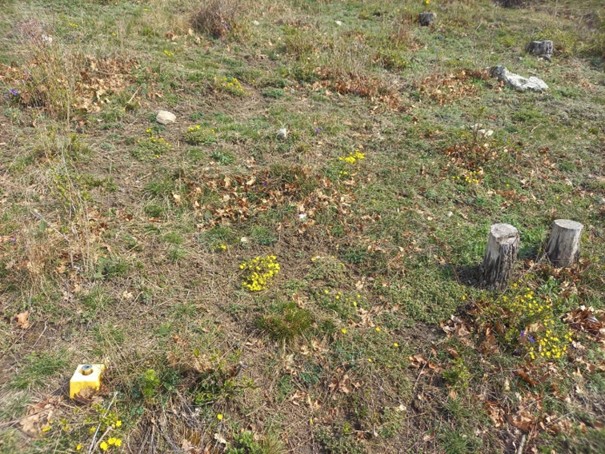
SCI Devínska Kobyla – the same site three years after the restoration. The area has seen a significant increase in species diversity, along with a rise in the number of rare species and species characteristic of habitat 6210.

Dwarf restharrow (Ononis pusilla) – a critically endangered species in Slovakia – appeared in areas where we carried out restoration interventions and habitat 6210 recovery as part of the CZ-SK SOUTH LIFE project.
6120 - Xeric sand calcareous grasslands
The habitat includes communities of predominantly annual, sand-requiring plants in areas of inland drifting sands. This habitat is found in four Sites of Community Importance (SCI) in Slovakia: Abov, Čenkov, Chotínske piesky, and Nesvadské piesky. It is an initial-type habitat that occurs only locally and in very small patches. Maintaining it requires supporting appropriate disturbance regimes and preventing overgrowth.
As part of the project, invasive plant species were removed at the SCI sites Abov and Čenkov, along with the restoration of grazing.

Habitat 6120 occupies the initial stages of drifting sands. Grazing and animal trampling help maintain this type of habitat.
6250 - Pannonic loess steppic grasslands
The habitat is found along the edges of old field bounds and roads on loess slopes with deeper soils. It consists of dry to semi-dry, species-rich grass-herb communities. The presence of tufted grass species along with continuous vegetation cover may resemble meadow communities. Within the project, this habitat is represented in six Sites of Community Importance (SCI) in Slovakia. These sites are among the most valuable examples of this habitat in the country.
As part of the CZ-SK SOUTH LIFE project, we carried out the removal of invasive and self-seeding trees, the restoration of mowing, and the reintroduction of grazing at the SCI sites Ploská hora, Starý vrch, Modrý vrch, Drieňová hora, and Seleštianska stráň. At the Ploská hora site, thanks to excellent cooperation with a local farmer and land users, invasive plant species were significantly suppressed. Additionally, arable land was grassed over, leading to an overall expansion of the site from the original 27 hectares to more than 100 hectares.
 SCI Ploská hora – at the beginning of the project, large parts of the site were overgrown with invasive species such as giant goldenrod (Solidago gigantea) and tree of heaven (Ailanthus altissima).
SCI Ploská hora – at the beginning of the project, large parts of the site were overgrown with invasive species such as giant goldenrod (Solidago gigantea) and tree of heaven (Ailanthus altissima).

SCI Ploská hora – thanks to the reintroduction of grazing, the invasive goldenrod was naturally suppressed. The tree of heaven was controlled through injection treatment.

Habitat 6250, EVL Ploská hora.
6260 – Pannonic sand steppes
The habitat occurs on dry, nutrient-poor sands and on frequently disturbed areas, such as firebreaks along railway tracks and military training grounds. It consists of species-rich grass and herb communities with a dominance of grasses and sedges. Low-growing or creeping herbs, mosses, and lichens are also present. This habitat is the focus of the project in four Sites of Community Importance (SCI) in Slovakia. The habitat is primarily threatened by overgrowth of dominant grass species, self-seeding trees, and the spread of invasive plants. Large areas of this habitat were destroyed by artificial afforestation with pines and locusts, especially during the socialist era.
As part of the CZ-SK SOUTH LIFE project, we carried out the removal of invasive plant species—tree of heaven (Ailanthus altissima) and common milkweed (Asclepias syriaca)—at the SCI sites Čenkov and Abov. Grazing with cattle, donkeys, and sheep was also reintroduced at the Čenkov and Chotínske piesky sites.

SCI Čenkov – the restoration of grazing with Hungarian steppe cattle on drifting sand habitats. This is the most valuable site for this habitat in Slovakia.
FOREST HABITATS
91D0 - Bog woodland
This type of habitat includes the following habitats: peat bog spruce forests, cranberry peat bogs, peat bog birch forests, and wetland pine forests. These habitats are part of the project's conservation efforts in four Sites of Community Importance (SCI) in the Czech Republic: Borkoviská Blata, Planičský rybník - Bobovec, Pohoří na Šumavě, and the Kapličky peat bog. The habitats have been disturbed by drainage for peat extraction, leading to changes in the original species composition. The project's goal is to restore the original water regime, reintroduce naturally occurring species, particularly the bog pine (Pinus rotundata), and support their development through regular mowing and the removal of non-native, competitive species.
As part of the project, the restoration of the water regime was carried out at the SCI site Kapličky peat bog, covering an area of 13 hectares. In addition, 20,000 individuals of the rare bog pine (Pinus rotundata) were planted, grown from seeds of original trees of this species from the region. Other restoration actions included the removal of invasive and non-native plant species and the restoration of mosaic mowing. These interventions were carried out at all four project sites where this habitat is present.

91E0 - Alluvial forests with Alnus glutinosa and Fraxinus excelsior
The habitats are located along watercourses, hillside forest springs, and terrain depressions, where regular flooding occurs due to surface water or groundwater saturation. These habitats are characterized by nitrophilous and hygrophilous species. The habitats are part of the project’s conservation efforts in four Sites of Community Importance (SCI) in the Czech Republic and five SCIs in Slovakia. The project's goals focus on supporting the original species composition through the planting of poplars and willows and the removal of non-native species.
As part of the project, a total of 31,506 seedlings of willows, poplars, ash trees, and other species typical of habitat 91E0 were planted. An important measure was also ensuring post-planting care – protection from wildlife and the removal of weeds and invasive species. Thanks to the effective implementation of these measures, the survival rate of the planted trees was very high (over 90%). Other measures included the removal of invasive plants.
 SCI Dunajské luhy – periodic flooding is characteristic of habitat 91E0.
SCI Dunajské luhy – periodic flooding is characteristic of habitat 91E0.

SCI Veľkolélsky ostrov – poplar individuals (Populus nigra, P. canescens) were planted. These species are typical for habitat 91E0.
91N0 - Pannonic inland sand dune thicket
This habitat is found only in the Site of Community Importance (SCI) Čenkov in Slovakia. Within the European Union, these habitats are now only present in Hungary. The habitat is characterized by a mosaic, discontinuous occurrence of white poplar and common juniper species. It is threatened by the presence of invasive species, particularly black locust and tree of heaven. The goal of the project is to suppress these invasive species.
As part of the project, invasive species such as tree of heaven (Ailanthus altissima) and common milkweed (Asclepias syriaca) were removed from a significant part of the Čenkov site. Habitat restoration was also supported by the reintroduction of grazing with cattle and donkeys, which was successfully implemented as part of the project.

SCI Čenkov – the extensive presence of invasive plants is one of the biggest threats to the target habitat 91N0.

SCI Čenkov – as part of the project, extensive removal of invasive species such as tree of heaven (Ailanthus altissima) and common milkweed (Asclepias syriaca) was carried out. The success of the interventions was very high.
SALT MARSHES AND PEAT BOGS
1340 – Inland salt meadows
The habitat occurs on saline soils with very high pH. In lowlands, salts crystallize on the soil surface after water evaporation, coming into direct contact with plant roots, which causes some plant species to develop stunted forms. The typical species composition represents a combination of salt-tolerant, hygrophilous, and calcareous species. This habitat is the focus of the project in 9 Sites of Community Importance (SCI) in Slovakia.
The habitat was traditionally maintained through animal grazing. Currently, it is mainly threatened by disturbances in the water regime and the disappearance of grazing. As a result, there is rapid spread of dominant grass species, as well as encroachment by woody and invasive plants at these sites.
As part of the project, we carried out the removal of invasive plants, restoration of the water regime, and the re-establishment of grazing at several sites in southern Slovakia. A sustainable grazing regime was restored through effective cooperation with local farmers, ensuring the long-term sustainability of the project's results, as well as benefits for local residents and communities.

SCI Mostové – habitat 1340

SCI Mostové – habitat 1340
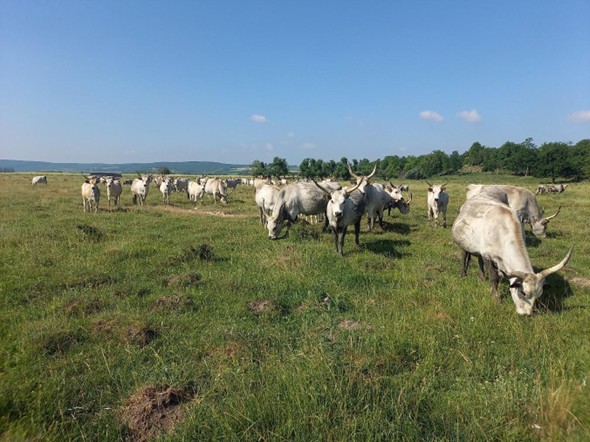
SCI Kamenínske slaniská – grazing of Hungarian grey steppe cattle, restored thanks to the LIFE program.
1530 – Pannonic salt steppes and salt marshes
The habitat occurs on muddy edges of periodic ponds. The main factors influencing this habitat are salinity and constant soil moisture. Another significant factor is the nitrate content in the soil, which affects the species composition of the habitat. Characteristic plants for this habitat include sweet galingale (Cyperus longus) and salt-tolerant sea wormwood (Artemisia maritima). This habitat is the focus of the project at two Sites of Community Importance (SCI) in Slovakia: Kamenínske slaniská and Panské lúky.
The habitat is threatened primarily by changes in the water regime (drainage and drying out) and the disappearance of grazing. As a result, there is rapid encroachment by dominant grass species, reeds, and invasive species. Consequently, this habitat is on the brink of extinction in Slovakia, with its current occurrence limited to very small areas at two locations.
As part of the project, the restoration of the water regime was carried out, and soil stripping was implemented to create shallow, periodically flooded depressions with saline soil. The long-term maintenance of the achieved results will be greatly supported by the restoration of grazing with horses and cattle, which will prevent the encroachment of areas with the restored habitat.
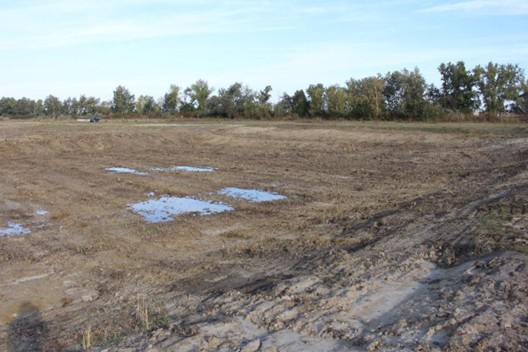
SCI Pavelské slanisko – restoration of an abandoned and degraded clay pit (creation of shallow banks and periodically flooded salt marshes at the bottom).

SCI Pavelské slanisko – the periodically flooded salt marshes restored within the project are an important habitat for rare plant and insect species. These habitats also serve as breeding grounds for rare bird species, such as the black-winged stilt (Himantopus himantopus).

The rare black-winged stilt (Himantopus himantopus) – nesting of 3 pairs was recorded on areas where restoration measures were implemented within the CZ-SK SOUTH LIFE project.

SCI Panské lúky – in the foreground, a periodically flooded salt marsh, with an optimal environment for the development of habitat 1530. This area will be sustainably maintained through horse grazing, which was restored in cooperation with local farmers.
7110 – Active raised bogs
The raised bog is a type of peat bog that forms due to atmospheric moisture and precipitation. It represents one of the most acidic and nutrient-poor habitats, as the only source of nutrients is rainfall. An upland bog is referred to as "active" when the process of peat formation occurs over most of the area. The characteristic relief of upland bogs alternates between elevated areas (tussocks) and depressions with open water surfaces. Most of the plant organisms in the habitat are sphagnum mosses, which actively contribute to the acidic and nutrient-poor environment, thereby limiting the presence of other species. In addition to sphagnum moss, the habitat also supports species of sedges and low shrubs such as bog rosemary, cranberry, or andromeda. The habitat is the target of the project at two Sites of Community Importance (SCI) in the Czech Republic: Pohoří na Šumavě and Kapličky peat bog. This type of habitat is also suitable for the species of interest in the project, the raised bog large ground beetle (Carabus menetriesi pacholei).
The habitat is threatened mainly by changes in water management – drainage via ditches. This leads to the decomposition of peat, rapid nutrient release, and the encroachment of dominant grass species and non-native plants.
In the CZ-SK SOUTH LIFE project, water management restoration was implemented, along with the removal of non-native plant species and the restoration of mosaic mowing. Further restoration efforts will continue even after the project ends.















